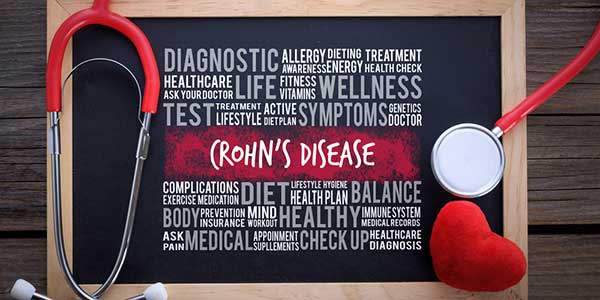
7 Ways to Eat Better with Crohn's Disease
This disease is characterized by ongoing inflammation within the gastrointestinal tract. Inflammation is an immune reaction designed to help heal the body following injury - imagine a cut on your finger turning a little pink and swelling slightly. The problem with Crohn's disease is that this inflammation is ongoing, also called chronic.
And it's painful. If you've ever suffered a bout of colitis, you know just how uncomfortable, agonizing, and debilitating it can be. Worrying about what foods to eat that won't trigger a reaction can send your head spinning at just about every meal.
Luckily, there is emerging research that helps explain things that may help control the symptoms of Crohn's disease, and prevent future attacks. While there is not one specific diet for Crohn's disease, there are certainly foods that may help you fare better, or worse.
The challenge for a Crohn's disease diet is multi-layered. First, just having this kind of chronic disease usually increases your need for nutrients and energy, specifically fat soluble vitamins like vitamin A, vitamin D, vitamin E, and vitamin K, due to malabsorption.
Overall, your calorie needs are higher as well. During a flare-up, it can be tempting to skip eating, making your risk for poor nutrient intake even greater. Making sure you are consuming enough calories and protein foods will help to promote healing and ensures your immune system is able to function as well.
There is no evidence to suggest that any particular food or diet causes, prevents or cures Crohn's disease, however, avoiding certain trigger foods can undoubtedly help reduce the severity of symptoms.
Avoiding insoluble fiber can help reducing bloating and cramping. Insoluble fiber is roughage and plant fiber that your body is not able to soften or digest. Foods that are high in insoluble fiber include leafy greens like cabbage, kale, spinach, and lettuce, dry whole grains, seeds, nuts, skins of fruits and vegetables, as well as bran cereals. Avoiding insoluble foods is also known as a low-residue diet, which is usually recommended by physicians as a helpful diet for people with Crohn's disease.
Probiotics have proven helpful when it comes to ensuring overall gastrointestinal health. Guaranteeing that you are consuming a supplement to containing lactobacillus species, and possibly also Bifidobacterium species can be beneficial.
Skip high-fat foods like butter, vegetable oils, fried foods, and heavy cream, as these may cause diarrhea and gas if your body is having trouble breaking down fat, which is common in inflammatory bowel diseases.
Avoid gum for a little while. Various foods, including diet snack bars, a variety of low-calorie beverages, and gum contain sugar alcohols, which can make symptoms of Crohn's disease like diarrhea, gas, and bloating even worse. Sugar alcohols are listed in the ingredient section of the food label as sorbitol, mannitol, xylitol, and erythritol. These are also found naturally in foods like prunes, pears, and peaches.
If you ever Googled how to eat with Crohn's Disease it's likely that a FODMAP diet has surfaced. Short for FODMAP Fermentable Oligo-Di-Monosaccharides and Polyols, the foods that contain FODMAP sugars are carbohydrates and sugar alcohols, which can cause lots of gas, bloating, stomach cramping, and diarrhea.
Foods that contain FODMAPs to limit on a diet for Crohn's disease include:
1. Fructose - found in honey, high fructose corn syrup, and fruits.
2. Lactose - found in dairy products like cheese, yogurt, milk, cream, and sour cream.
3. Vegetables, cereals and legumes can contain oligosaccharides that may irritate the gastrointestinal tract.
4. Sugar alcohols - found in sugar-free mints, gum, diet drinks, and naturally in some fruits.
7 Ways to Eat Better with Crohn's Disease
1. Make sure you are eating to heal - you need additional nutrients, calories, and protein.
2. Skip roughage and insoluble fiber - these may aggravate your symptoms.
3. Skip lactose - a milk sugar found in dairy products.
4. Consider a probiotic - taking one a day may help establish a healthy flora in your gut.
5. Skip high-fat foods - these can cause diarrhea with maldigestion, gas, and bloating.
6. Avoid chewing gum, snack bars, and diet drinks with sugar alcohols in them.
7. Limit FODMAP containing foods - this may be difficult, so make sure you speak with a dietitian.
Example Diet for Crohn's Disease
Breakfast Ideas
Decaffeinated coffee
Cup of juice, such as no-pulp orange juice or cranberry juice
Cream of wheat or grits
Lean ham or lowfat turkey/chicken sausage
Scrambled eggs
Waffles, French toast with cinnamon or White-bread toast with and grape jelly (no seeds)
Lunch Ideas
Baked chicken, white rice, cooked carrots green beans
Salad with baked chicken, American cheese, smooth salad dressing, white dinner roll
Hamburger with white seedless bun, ketchup, and mustard (no whole mustard seeds)
Decaf black iced tea
Dinner
Tender roast beef, white rice, cooked carrots or spinach, white dinner roll with small pat of butter
Pasta with pork medallions and cooked zucchini squash, and chocolate pudding for dessert
Baked chicken, white rice or baked potato without skin, and cooked yellow squash
Broiled fish, white rice, and steamed zucchini squash
Decaf green tea






